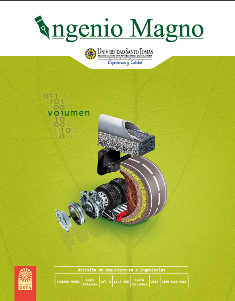El Ensayo, Para Formar Profesionales Reflexivos
Main Article Content
Abstract
Downloads
Article Details
DECLARATION OF ORGINIALITY OF SUBMITTED ARTICLE
With this document, I/We certify that the article submitted for possible publication in the institutional journal INGENIO MAGNO of the Research Center Alberto Magno CIIAM of the University Santo Tomás, Tunja campus, is entirely of my(our) own writing, and is a product of my(our) direct intellectual contribution to knowledge.
All data and references to completed publications are duly identified with their respective bibliographical entries and in the citations thus highlighted. If any adjustment or correction is needed, I(we) will contact the journal authorities in advance.
Due to that stated above, I(we) declare that the entirety of the submitted material is in accordance with applicable laws regarding intellectual and industrial property, and therefore, I(we) hold myself(ourselves) responsible for any complaint related to it.
If the submitted article is published, I(we) declare that I(we) fully relinquish publishing rights of the article to the University Santo Tomás, Tunja campus. As remuneration for this relinquishment of rights, I(we) declare my(our) agreement to receive two (2) copies of the edition of the journal in which my(our) article appears.
References
Carmona G., María. (2008). “Hacia una formación docente reflexiva y crítica: fundamentos filosóficos”. Revista de Teoría y Didáctica de las Ciencias Sociales. Mérida-Venezuela. ISSN 1316-9505. Enero-Diciembre. Nº 13 pp. 125-146.
Caro. (2002). “Concepciones pedagógicas en los laboratorios de Ingeniería Civil de la Universidad de Los Andes”. Universidad de Los Andes.
Caro, S. y Reyes J. (2003). “Prácticas docentes que promueven el aprendizaje activo en Ingeniería Civil”. Revista de Ingeniería. Universidad de Los Andes, 18, 48 – 55.
Chrobak, R. y Prieto A. (2010). “La herramienta UVE del conocimiento para favorecer la creatividad de docentes y estudiantes”. Anales de Psicología, Vol. 26, Núm. 2, julio, pp. 259- 266. Universidad de Murcia. España.
Dewey, J. (1998). Cómo pensamos. Barcelona, España: Paidós.
Elliot, J. (2005). El cambio educativo desde la investigación-acción, Madrid: ediciones Morata.
Gadamer, H. (2007). Verdad y Método, Salamanca: gráficas Verona.
Leonard, A. (2011). La historia de las cosas, Bogotá: Fondo de Cultura
Medina, J. (2007). “Propuesta para la elaboración de ensayos académicos”, En: Quaestiones Disputatae, V1. N 3. pp 97-101, julio, diciembre.
Not, L. (2002). Las pedagogías del conocimiento. México: Fondo de Cultura Económica.
Ochoa, L. “¿Cómo redactar un ensayo?: guía mínima”, Bogotá: Universidad Santo Tomás, copias sin pie de imprenta.
Perico, N. (2010). “Por qué escribir y cómo escribir artículos”, En: L’esprit Ingenieux, V.1, pp. 64-65, enero-diciembre.
Ruiz, D. Magallón, J., y Muñoz, E., y. (2010). “Herramientas de aprendizaje activo en las asignaturas de Ingeniería Estructural”. Ingeniería y Universidad, enero-junio, vol. 10, número 001, pp. 97-115, Bogotá: Pontificia Universidad Javeriana.
Schon, D. (1992). La formación de profesionales reflexivos. Madrid, España: Paidós.
Serafini, M. (1994). Cómo se escribe, Buenos Aires: Paidós
Vásquez, F. “El Ensayo: diez pistas para su composición”, Bogotá: Universidad Javeriana, copias sin pie de imprenta.
Zemelman, H. (1992). Los horizontes de la razón. Dialéctica y apropiación del presente. D.F. México, México, Antropos, editorial del hombre.

